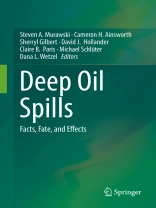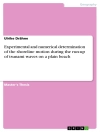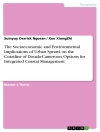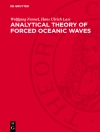The demand for oil and gas has brought exploration and production to unprecedented depths of the world’s oceans. Currently, over 50% of the oil from the Gulf of Mexico now comes from waters in excess of 1, 500 meters (one mile) deep, where no oil was produced just 20 years ago. The Deepwater Horizon oil spill blowout did much to change the perception of oil spills as coming just from tanker accidents, train derailments, and pipeline ruptures. In fact, beginning with the Ixtoc 1 spill off Campeche, Mexico in 1979-1980, there have been a series of large spill events originating at the sea bottom and creating a myriad of new environmental and well control challenges. This volume explores the physics, chemistry, sub-surface oil deposition and environmental impacts of deep oil spills. Key lessons learned from the responses to previous deep spills, as well as unresolved scientific questions for additional research are highlighted, all of which are appropriate for governmental regulators, politicians, industry decision-makers, first responders, researchers and students wanting an incisive overview of issues surrounding deep-water oil and gas production.
Spis treści
Section I. Introduction.- 1. Introduction to the Volume.- Section II. Physics and Chemistry of Deep Oil Well Blowouts.- 2. The importance of understanding fundamental physics and chemistry of deep oil blowouts.- 3. Physical and chemical properties of oil and gas under reservoir and deep-sea conditions.- 4. Jet formation at the blowout site.- 5. Behavior of rising droplets and bubbles – impact on the physics of deep-sea blowouts and oil fate.- Section III. Transport and Degradation of Oil and Gas from Deep Spills.- 6. The importance of understanding transport and degradation of oil and gasses from deep sea blowouts.- 7. Biodegradation of petroleum hydrocarbons in the deep sea.- 8 Partitioning of organics between oil and water phases with and without the application of dispersants.- 9. Dynamic coupling of near-field and far-field models.- 10. Effects of oil properties and slick thickness on dispersant field effectiveness and oil fate.- 11. Far-field modeling of a deep-sea blowout: sensitivity studies of initial conditions, biodegradation, sedimentation and sub-surface dispersant injection on surface slicks and oil plume concentrations.- Section IV. Oil Spill Records in Deep Sea Sediments.- 12. Formation and sinking of MOSSFA (Marine Oil Snow Sedimentation and Flocculent Accumulation) events: Past and Present.- 13. The sedimentary record of MOSSFA events in the Gulf of Mexico: A comparison of the Deepwater Horizon (2010) and Ixtoc 1 (1979) oil spills.- 14. Characterization of the sedimentation associated with the Deepwater Horizon blowout: depositional pulse, initial response, and stabilization.- 15. Applications of FTICR-MS in oil spill studies.- 16. Changes in redox conditions of surface sediments following the Deepwater Horizon and Ixtoc 1 events.- 17. Long-term preservation of oil spill events in sediments: the case for the Deepwater Horizon spill in the northern Gulf of Mexico.- 18. Effect of marine snow on microbial oil degradation.- 19. Molecular legacy of the 1979 Ixtoc 1 oil spill in deep-sea sediments of the southern Gulf of Mexico.- 20. 40 years of weathering of coastal oil residues in the southern Gulf of Mexico.- Section V. Impacts of Deep Spills on Plankton, Fishes, and Protected Resources.- 21. Overview of ecological impacts of deep spills.- 22. Deep-sea benthic faunal impacts and community evolution before, during and after the Deepwater Horizon event.- 23. Impact and resilience of benthic foraminifera in the aftermath of the Deepwater Horizon and Ixtoc 1 oil spills.- 24. Chronic sublethal effects observed in wild caught fish following two major oil spills in the Gulf of Mexico: Deepwater Horizon and Ixtoc 1.- 25. Impacts of deep spills on fish and fisheries.- 26. Impacts of the Deepwater Horizon oil spill on marine mammals and sea turtles.- Section VI. Toxicology of Deep Oil Spills.- 27. Ecotoxicology of deep ocean spills.- 28 A synthesis of Deepwater Horizon oil, chemical dispersant and chemically dispersed oil aquatic standard laboratory acute and chronic toxicity studies.- 29. Digging deeper than LC/EC50: non-traditional endpoints and non-model species in oil spill toxicology.- 30. Genetics and oil: transcriptomics, epigenetics and population genomics as tools to understand animal responses to exposure across different time scales.- Section VI. I Ecosystem-level modeling of deep oil spill impacts.- 31. A synthesis of top down and bottom up impacts of the Deepwater Horizon oil spill using ecosystem modeling.- 32. Comparing ecosystem model outcomes between Ixtoc 1 and Deepwater Horizon oil spills.- 33. Effects of the Deepwater Horizon oil spill on Human Communities: Catch and Economic Impacts.- Section VIII. Summary.- 34. Summary of Major Themes – Deep Oil Spills.- Index.
O autorze
Steven A. Murawski is a Professor and Downtown Partnership/Peter Betzer Endowed Chair of Biological Oceanography at the University of South Florida. Murawski currently serves as director of the C-IMAGE consortium conducting interdisciplinary oil-spill related research. Prior to his current position, he was Director of Scientific Programs and Chief Science Advisor for the US National Marine Fisheries Service. He is a fishery biologist with interests in population and ecosystem ecology and dynamics. He has published nearly 200 journal articles, technical reports and book chapters. Awards include the Department of Commerce Gold Medal. His Ph.D. is in Wildlife and Fisheries Biology from the University of Massachusetts-Amherst.
Cameron H. Ainsworth is an Associate Professor of Fisheries Science at the University of South Florida. He uses ‘end-to-end’ models and other means to study anthropogenic influences on marine ecosystems. His recent work has considered fishing, climate change and oil spills as drivers of ecosystem change. He keeps an applied focus, working with NOAA and state fisheries managers on common research themes and serving as a member of the Ecosystem Science and Statistical Committee of the Gulf of Mexico Fisheries Management Council. He has published over 100 peer-reviewed and technical articles. Awards include a Sloan Research Fellowship for early career scientists and an Outstanding Faculty Award. His Ph.D. is in Resource Management and Environmental Studies from the University of British Columbia in Vancouver, Canada.
Sherryl Gilbert is the deputy director of the C-IMAGE consortium operated at the College of Marine Science at the University of South Florida. Gilbert has served as the center’s operational core since 2011, coordinating research and management efforts. Prior to 2011, Gilbert was the technical director of the Ocean Modelingand Prediction Laboratory and was heavily involved in ocean sensor development, testing, and its application to study coastal processes. She is a physical oceanographer with broader interests in Gulf conservation efforts. Ms. Gilbert holds a M.S. in Marine Science from the University of South Florida.
David J. Hollander is a Professor of Chemical Oceanography and Sedimentary Geochemistry at the University of South Florida. Hollander currently serves as the Chief Science Officer developing and overseeing the wide scope of interdisciplinary scientific activities conducted by C-IMAGE. Since the Deepwater Horizon Blowout event in 2010, he has played a critical role in scientific discovery, public communications of findings, and influencing the research, response efforts and policies of federal agencies. He is an isotope and molecular organic geochemist focusing on climate, environment and ecosystem changes at both natural and anthropogenic time-scales. He has over 100 peer-reviewed paper and received his Ph.D. from the Swiss Federal Institute of Technology (ETH-Zurich).
Claire B. Paris-Limouzy is a Professor of Ocean Sciences at the Rosenstiel School of Marine and Atmospheric Sciences. Paris is a PI for the C-IMAGE consortium, leading oil-spill modeling research. She is a biological oceanographer with interests in larval ecology and biophysical interactions. She has over 170 publications, including the probabilistic open-source Connectivity Modeling System used worldwide to predict dispersion and population connectivity and in NOAA fisheries stock assessment. She is President-Elect of the Early Life History section of the American Fishery Society and the 2018 AGU Rachel Carson Lecturer. Paris is interdisciplinary at heart with a Ph.D. is in Coastal Oceanography from the State University of New York at Stony Brook.
Michael Schlüter owns the Chair of ‘Fluid Mechanics for Multiphase Systems’ at the Hamburg University of Technology and is head of the Institute of Multiphase Flows. He also serves as coordinator of the DFG Priority Program “Reactive Bubble Columns“ and as President of the Working Party “Multiphase Fluid Flow“ in the European Federation of Chemical Engineering. His research interest is primarily in the field of multiscale transport phenomena in chemical and bioprocess engineering, reactor development, design and scale-up. He has published over 50 papers and completed work on more than 15 books.
Dana L. Wetzel is a Senior Scientist, Program Manager of the Environmental Laboratory for Forensics, and Eminent Scholar at Mote Marine Laboratory. Her research focuses on sub-lethal effects of chemical contaminant exposure on essential biochemical processes in marine organisms from corals to polar bears. Wetzel has served on panels to develop and assess protocols for oil spill response research and for oil dispersant use in the Arctic. Her Ph.D. is in Chemical Oceanography from the University of South Florida, where she was the recipient of both the Robert M. Garrels and Gulf Oceanographic Charitable Trust Fellowships.












